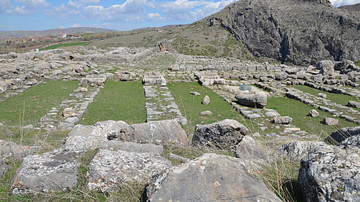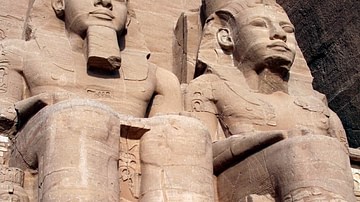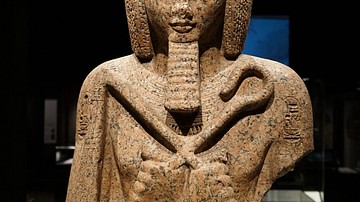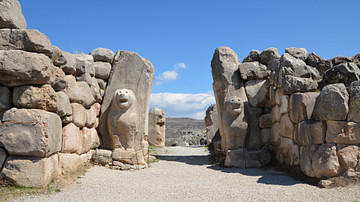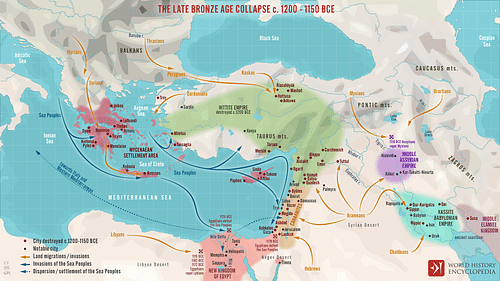
The Sea Peoples were a confederacy of naval raiders who harried the coastal towns and cities of the Mediterranean region between c. 1276-1178 BCE, concentrating their efforts especially on Egypt. They are considered one of the major contributing causes to the Bronze Age Collapse (c. 1250-c.1150 BCE) and were once regarded as the primary cause.
The nationality of the Sea Peoples remains a mystery as the existing records of their activities are mainly Egyptian sources who only describe them in terms of battle such as the record from the Stele at Tanis which reads, in part, “They came from the sea in their war ships and none could stand against them." This description is typical of Egyptian references to these mysterious invaders.
Names of the tribes which comprised the Sea Peoples have been given in Egyptian records as the Sherden, the Sheklesh, Lukka, Tursha and Akawasha. Outside Egypt, they also assaulted the regions of the Hittite Empire, the Levant, and other areas around the Mediterranean coast. Their origin and identity has been suggested (and debated) to be Etruscan/Trojan to Italian, Philistine, Mycenaen and even Minoan but, as no accounts discovered thus far shed any more light on the question than what is presently known, any such claims must remain mere conjecture.
No ancient inscription names the coalition as "Sea Peoples" - this is a modern-day designation first coined by the French Egyptologist Gaston Maspero in c. 1881 CE. Maspero came up with the term because the ancient reports claim that these tribes came "from the sea" or from "the islands" but they never say which sea or which islands and so the Sea Peoples' origin remains unknown.
The three great pharaohs who record their conflicts and victories over the Sea Peoples are Ramesses II (The Great, r. 1279-1213 BCE), his son and successor Merenptah (r. 1213-1203 BCE), and Ramesses III (r. 1186-1155 BCE). All three claimed great victories over their adversaries and their inscriptions provide the most detailed evidence of the Sea Peoples.
The Sea Peoples & Ramesses II
Ramesses the Great was one of the most effective rulers in the history of ancient Egypt and among his many accomplishments was securing the borders against invasion by nomadic tribes and securing the trade routes vital to the country's economy. Early in his reign, the Hittites seized the important trade center of Kadesh (in modern-day Syria) and in 1274 BCE Ramesses led his army to drive them out. Ramesses claimed a great victory and had the story inscribed in detail and read to the people.
His claim of total victory is disputed by the Hittite account claiming their own but the inscription is important for many other reasons than Ramesses would have had in mind and, among them, what it says about the Sea Peoples. In his account, the Sea Peoples are mentioned as allies of the Hittites but also as serving in his own army as mercenaries. No mention is made of where they came from or who they were which suggests to scholars that the audience would have already had this information; the Sea Peoples needed no introduction.
Ramesses also relates how, in the second year of his reign, he defeated these people in a naval battle off the coast of Egypt. Ramesses allowed the Sea Peoples' war ships and their supply and cargo vessels to approach the mouth of the Nile where he had a small Egyptian fleet positioned in a defensive formation. He then waited in the wings for the Sea Peoples to attack what seemed to be an insignificant force before launching his full attack upon them from their flanks and sinking their ships. This battle seems to have involved only the Sherdan Sea Peoples or, at least, they are the only ones mentioned because, after the battle, many were pressed into Ramesses' army and some served as his elite body guard. Ramesses, always very confident in his inscriptions, gives the impression that he had neutralized the threat of the Sea Peoples but his successors' inscriptions tell another story.
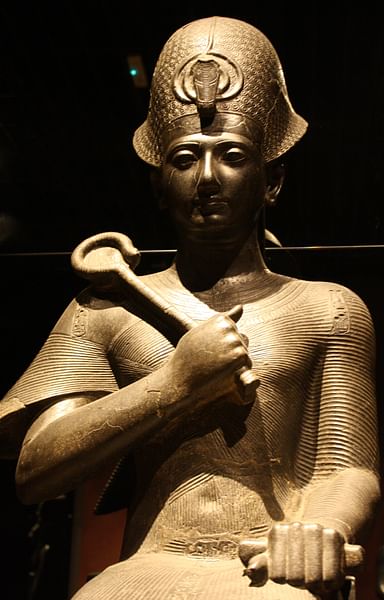
Merenptah's Inscription
Merenptah continued to be troubled by the Sea Peoples who allied themselves with the Libyans to invade the Nile Delta. Merenptah writes how, in the fifth year of his reign (1209 BCE) Mereye, the chief of the Libyans, allied with the Sea Peoples to invade Egypt. He refers to the Libyan allies as coming "from the seas to the north" and names the territories as Ekwesh, Teresh, Lukka, Sherden, and Shekelesh. Scholars have since tried to identify where these lands were and what names they came to be known by but without success. There are as many theories surrounding who the Sea Peoples were as there are scholars to refute them. Whoever they were, Merenptah describes them as formidable adversaries and, in his inscription on the walls of the Temple of Karnak and on the stele from his funerary temple, takes great pride in defeating them.
At this point in their history it seems the Sea Peoples were seeking to establish permanent settlements in Egypt as the invading force brought with them scores of household goods and building tools. Merenptah, after praying, fasting, and consulting the gods in the matter of strategy, met the Sea Peoples on the field at Pi-yer where the combined Egyptian force of infantry, cavalry, and archers slew over 6,000 of their opponents and took captive members of the royal Libyan family. Merenptah claimed complete victory and Egypt's borders were again secure. To celebrate his accomplishment, he had the story immortalized in the Karnak inscription and also on the famous Merenptah Stele found in his funerary temple at Thebes. The Merenptah Stele's conclusion reads, in part:
The princes prostrate themselves, saying, "Peace!" Not one of Nine Bows dares raise his head; Tehenu is plundered while Hatti is peaceful, Canaan is seized by every evil, Ashkelon is carried off and Gezer is seized, Yenoam is made as that which never existed, Israel is wasted without seed, Khor is made a widow of Egypt, All the lands are at peace. Everyone who travels has been subdued by the King of Upper and Lower Egypt.
The "Nine Bows" mentioned is the customary term the Egyptians gave their enemies and Tehenu is the name for Libya. The inscription is announcing how Merenptah has defeated all the contentious regions who rose against Egypt and subdued them, bringing peace. The Merenptah Stele is the first mention of Israel in recorded history but, interestingly, refers not to a country or region but to a people. Scholars still do not know what this reference means. Like the Sea Peoples, this reference to Israel continues to intrigue historians and researchers in the present day. Merenptah himself was not concerned with Israel or with any of the other countries he lists; he was satisfied that the Sea Peoples had been defeated and Egypt secured for the future. Like his predecessor, however, Merenptah would be wrong and the Sea Peoples would return.
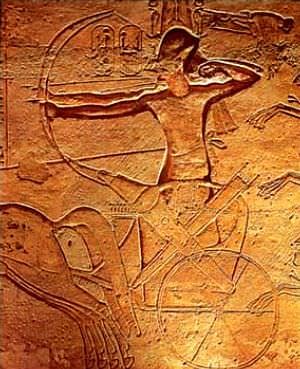
Ramesses III & The Battle of Xois
During the reign of the Pharaoh Ramesses III the Sea Peoples attacked and destroyed the Egyptian trading center at Kadesh and then again attempted an invasion of Egypt. They began their activities with quick raids along the coast (as they had done in the time of Ramesses II) before driving for the Delta. Ramesses III defeated them in 1180 BCE but they returned in force. In his own victory inscription, Ramesses III describes the invasion:
The foreign countries conspired in their islands. All at once the lands were removed and scattered in the fray. No land could resist their arms, from Hatti, Kode, Carchemish, Arzawa, and Alashiya on - being cut off at one time. A camp was set up in Amurru. They desolated its people and its land was like that which had never existed. They were coming forward toward Egypt, while the flame was prepared for them. Their confederation was the Peleset, Tjeker, Shekelesh, Denen, and Weshesh, lands united. They laid their hands upon the lands as far as the circuit of the earth, their hearts were confident and trusting as they said "Our plans will succeed!"
The countries mentioned in the confederation of Sea Peoples might be the regions of Palestine (Peleset) or Syria (Tjeker) but this is uncertain. It is clear, though, that these are the same people - with some additions - who attacked Egypt with the Libyans in the time of Merenptah. In this invasion, as in the earlier one, the Sea Peoples were allied with Libyans and, as Ramesses III notes, they were confident of victory. They had already destroyed the Hittite state (referred to in the inscription as Hatti) in c. 1200 BCE and when Ramesses III writes, "they were coming forward toward Egypt" he would most likely be saying they were advancing steadily without opposition.
Ramesses III would have known of his predecessors' clashes with these people and that they were to be taken very seriously. He decided against a field engagement and chose guerilla tactics as a strategy instead. He set up ambushes along the coast and down the Nile Delta and made especially effective use of his archers, positioning them hidden along the shoreline to rain down arrows on the ships at his signal. Once the ships' crew was dead or drowning the vessels were set on fire with flaming arrows.
The attack by sea had been crushed and Ramesses III then turned his attention to what was left of the invading force on land. He employed the same tactics as before and the Sea Peoples were finally defeated off the city of Xois in 1178 BCE. Egyptian records, again, detail a glorious victory in which many of the Sea Peoples were slain and others taken captive and pressed into the Egyptian army and navy or sold as slaves.
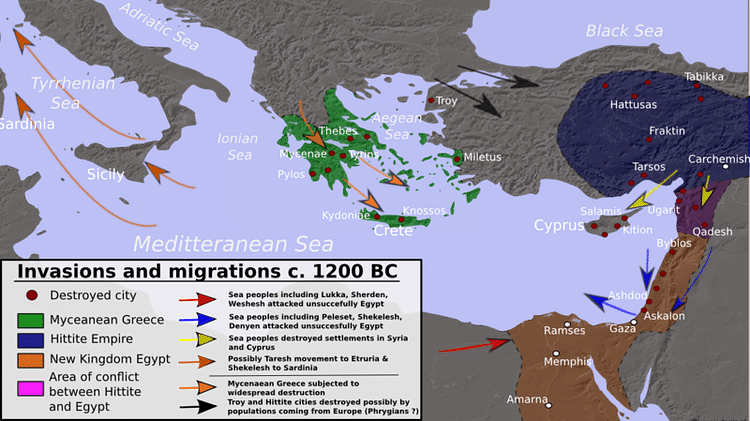
Although Ramesses III had saved Egypt from conquest, the war was so expensive it drained the Royal Treasury and the tomb builders at the village of Set Maat (modern Deir el-Medina) could not be paid. This led to the first labor strike in recorded history where the workers walked off the job and refused to return until they were fully compensated.
After their defeat by Ramesses III the Sea Peoples vanish from history, the survivors of the battle perhaps being assimilated into Egyptian culture. No records indicate where they came from and there are no accounts of them after 1178 BCE but, for almost one hundred years, they were the most feared sea raiders in the Mediterranean region and a constant challenge to the might and prosperity of Egypt.
The Enduring Mystery
As noted above, there is no agreement on who the Sea Peoples were even though one will find plenty of scholars and would-be scholars arguing heatedly for their particular claim. The Egyptian inscriptions discussed here provide almost all there is to know of these people outside of references in letters from the Hittites and Assyrians which shed no more light on the subject. That they were well known to the Egyptians is clear from the fact that they are never introduced as a foreign people and the possibility they were friends, or even allies, of Egypt is suggested by their presence in the army of Ramesses the Great and the sense of surprise expressed at the invasions. Historian Marc van de Mieroop writes:
Both Merenptah and Ramesses III present [the attacks] as sudden events, unforeseen and with massive numbers of people involved. Ramesses III's reliefs even show carts loaded with women, children, and household goods, as if a population movement was involved. His account of the Sea Peoples' appearance in the north of the eastern Mediterranean suggests that it was unexpected, very sudden, and highly destructive. But Merenptah had reported occurrences of the same type thirty years earlier. Nor were the names of the members of the Sea Peoples new in the Egyptian record. Several of them appeared decades earlier. (251-252)
The Sea Peoples are also mentioned in the literature of Egypt - in The Tale of Wenamun most notably - where they appear as familiar figures in the Mediterranean landscape. Why these people rose up so regularly against Egypt - if, in fact, they did - continues to mystify historians and scholars. Historians such as Marc van de Mieroop believe the question of the Sea Peoples' identity will never be known and there is no longer a point in trying to discover it. He writes, "One can wonder why the Sea Peoples have engendered so much passion" and states, "Why they still appear in every textbook on world history remains to be explained" (259). The explanation is simple though: the Sea Peoples' actual identity remains a mystery and human beings have always been drawn to the mysterious - and always will be.
